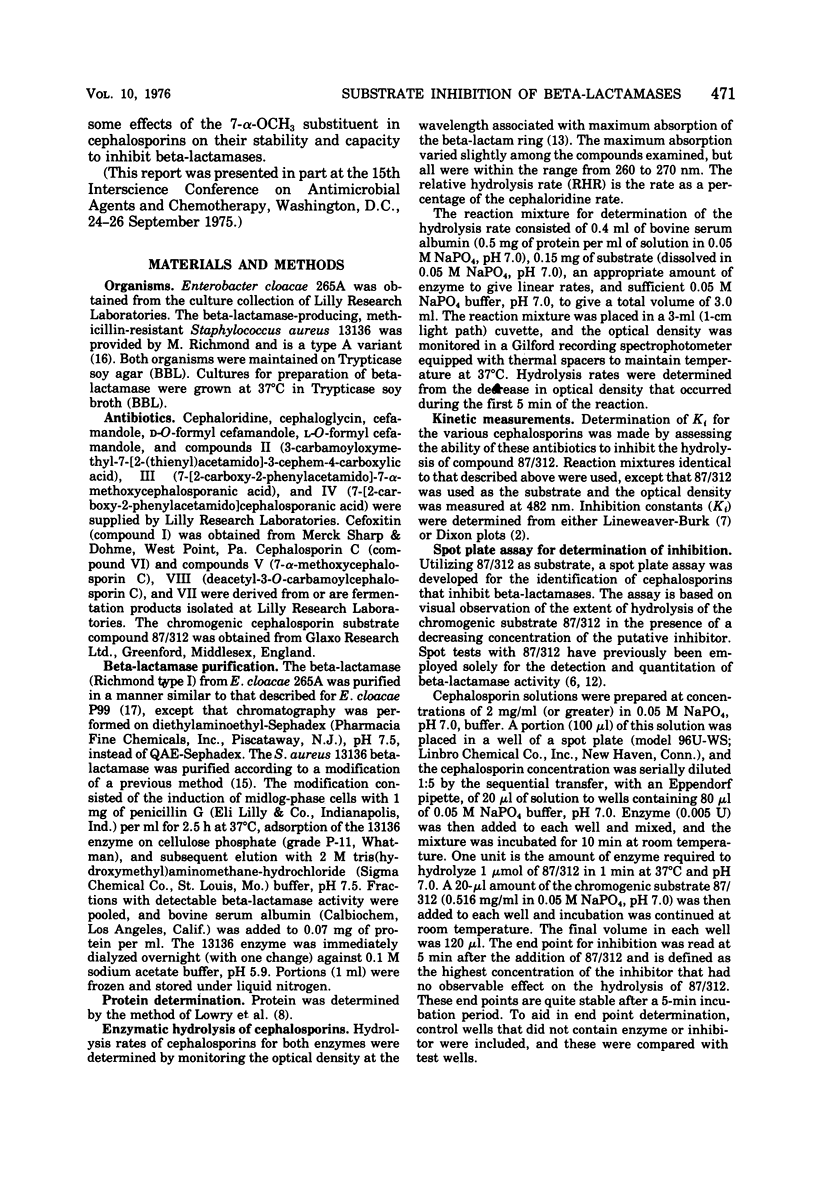Abstract
Selected cephalosporins, including cefamandole, cephaloridine, cephaloglycin, and cefoxitin, were examined for their ability to inhibit the enzymatic activity of and act as substrates for beta-lactamases produced by Enterobacter cloacae and Staphylococcus aureus. Enzyme inhibition was determined by Michaelis-Menten kinetic measurements and by a spot plate assay using a chromogenic substrate (Glaxo compound 87/312). These two methods provide comparable estimates of kinetic parameters. Inhibition of beta-lactamase, as measured by these two methods, was generally found to correlate with resistance to hydrolysis and is proposed as a preliminary method of assessing susceptibility of cephalosporins to beta-lactamase hydrolysis. Four 7-αOCH3, 7-αH cephalosporin analogue pairs were also examined. The presence of the 7-αOCH3 substituent invariably resulted in reduced susceptibility to enzymatic hydrolysis, regardless of the other C7 substituent. The 7-αOCH3 compounds were also better inhibitors than were their 7-αH analogues, with the exception that 7-αOCH3 compounds having C7 adipic acid substituents were less inhibitory to the S. aureus enzyme than were the corresponding 7-αH analogues. Response of these two enzymes to 7-αOCH3 and 7-αH cephalosporins suggests that beta-lactamase hydrolysis of these compounds involves attack at the alpha side of the betalactam ring.
Full text
PDF





Selected References
These references are in PubMed. This may not be the complete list of references from this article.
- Cornelis G. Distribution of beta-lactamases A and B in some groups of Yersinia enterocolitica and their role in resistance. J Gen Microbiol. 1975 Dec;91(2):391–402. doi: 10.1099/00221287-91-2-391. [DOI] [PubMed] [Google Scholar]
- DIXON M. The determination of enzyme inhibitor constants. Biochem J. 1953 Aug;55(1):170–171. doi: 10.1042/bj0550170. [DOI] [PMC free article] [PubMed] [Google Scholar]
- Ho P. P., Towner R. D., Indelicato J. M., Spitzer W. A., Koppel G. A. Biochemical and microbiological studies on 6-substituted penicillins. J Antibiot (Tokyo) 1972 Oct;25(10):627–628. doi: 10.7164/antibiotics.25.627. [DOI] [PubMed] [Google Scholar]
- Ho P. P., Towner R. D., Indelicato J. M., Wilham W. J., Spitzer W. A., Koppel G. A. Letter: Biochemical and microbiological studies on 7-methoxycephalosporins. J Antibiot (Tokyo) 1973 May;26(5):313–314. doi: 10.7164/antibiotics.26.313. [DOI] [PubMed] [Google Scholar]
- Indelicato J. M., Wilham W. L. Effect of 6-alpha substitution in penicillins and 7-beta substitution in cephalosporins upon beta-lactam reactivity. J Med Chem. 1974 May;17(5):528–529. doi: 10.1021/jm00251a012. [DOI] [PubMed] [Google Scholar]
- Kammer R. B., Preston D. A., Turner J. R., Hawley L. C. Rapid detection of ampicillin-resistant Haemophilus influenzae and their susceptibility to sixteen antibiotics. Antimicrob Agents Chemother. 1975 Jul;8(1):91–94. doi: 10.1128/aac.8.1.91. [DOI] [PMC free article] [PubMed] [Google Scholar]
- LOWRY O. H., ROSEBROUGH N. J., FARR A. L., RANDALL R. J. Protein measurement with the Folin phenol reagent. J Biol Chem. 1951 Nov;193(1):265–275. [PubMed] [Google Scholar]
- Nagarajan R., Boeck L. D., Gorman M., Hamill R. L., Higgens C. E., Hoehn M. M., Stark W. M., Whitney J. G. Beta-lactam antibiotics from Streptomyces. J Am Chem Soc. 1971 May 5;93(9):2308–2310. doi: 10.1021/ja00738a035. [DOI] [PubMed] [Google Scholar]
- Neu H. C. Cefamandole, a cephalosporin antibiotic with an unusually wide spectrum of activity. Antimicrob Agents Chemother. 1974 Aug;6(2):177–182. doi: 10.1128/aac.6.2.177. [DOI] [PMC free article] [PubMed] [Google Scholar]
- Neu H. C. Cefoxitin, a semisynthetic cephamycin antibiotic: antibacterial spectrum and resistance to hydrolysis by gram-negative beta-lactamases. Antimicrob Agents Chemother. 1974 Aug;6(2):170–176. doi: 10.1128/aac.6.2.170. [DOI] [PMC free article] [PubMed] [Google Scholar]
- O'Callaghan C. H., Morris A., Kirby S. M., Shingler A. H. Novel method for detection of beta-lactamases by using a chromogenic cephalosporin substrate. Antimicrob Agents Chemother. 1972 Apr;1(4):283–288. doi: 10.1128/aac.1.4.283. [DOI] [PMC free article] [PubMed] [Google Scholar]
- Onishi H. R., Daoust D. R., Zimmerman S. B., Hendlin D., Stapley E. O. Cefoxitin, a semisynthetic cephamycin antibiotic: resistance to beta-lactamase inactivation. Antimicrob Agents Chemother. 1974 Jan;5(1):38–48. doi: 10.1128/aac.5.1.38. [DOI] [PMC free article] [PubMed] [Google Scholar]
- RICHMOND M. H. PURIFICATION AND PROPERTIES OF THE EXOPENICILLINASE FROM STAPHYLOCOCCUS AUREUS. Biochem J. 1963 Sep;88:452–459. doi: 10.1042/bj0880452. [DOI] [PMC free article] [PubMed] [Google Scholar]
- RICHMOND M. H. WILD-TYPE VARIANTS OF EXOPENICILLINASE FROM STAPHYLOCOCCUS AUREUS. Biochem J. 1965 Mar;94:584–593. doi: 10.1042/bj0940584. [DOI] [PMC free article] [PubMed] [Google Scholar]
- Ross G. W., Boulton M. G. Purification of beta-lactamases on QAE-sephadex. Biochim Biophys Acta. 1973 Jun 6;309(2):430–439. doi: 10.1016/0005-2744(73)90041-7. [DOI] [PubMed] [Google Scholar]
- Stapley E. O., Jackson M., Hernandez S., Zimmerman S. B., Currie S. A., Mochales S., Mata J. M., Woodruff H. B., Hendlin D. Cephamycins, a new family of beta-lactam antibiotics. I. Production by actinomycetes, including Streptomyces lactamdurans sp. n. Antimicrob Agents Chemother. 1972 Sep;2(3):122–131. doi: 10.1128/aac.2.3.122. [DOI] [PMC free article] [PubMed] [Google Scholar]
- Tipper D. J., Strominger J. L. Mechanism of action of penicillins: a proposal based on their structural similarity to acyl-D-alanyl-D-alanine. Proc Natl Acad Sci U S A. 1965 Oct;54(4):1133–1141. doi: 10.1073/pnas.54.4.1133. [DOI] [PMC free article] [PubMed] [Google Scholar]
- Tsang J. C., Sansing G. A., Miller M. A. Relation of beta-lactamase activity to antimicrobial susceptibility in Serratia marcescens. Antimicrob Agents Chemother. 1975 Sep;8(3):277–281. doi: 10.1128/aac.8.3.277. [DOI] [PMC free article] [PubMed] [Google Scholar]
- Wallick H., Hendlin D. Cefoxitin, a semisynthetic cephamycin antibiotic: susceptibility studies. Antimicrob Agents Chemother. 1974 Jan;5(1):25–32. doi: 10.1128/aac.5.1.25. [DOI] [PMC free article] [PubMed] [Google Scholar]


